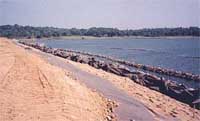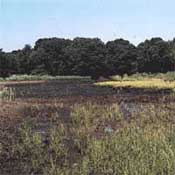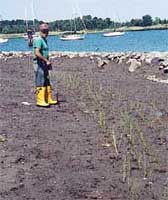|
Naval Construction Battalion Center
 |
|
NCBC landfill cap soon after completion.
|
The Davisville Naval Construction Battalion Center (NCBC) site, contaminated with PCBs, PAHs, and inorganics, is adjacent to Narragansett Bay and Allen Harbor, Rhode Island. This area is of special concern because it supports commercial and recreation fisheries. NOAA played a key role in actively pursuing remediation and habitat restoration activities in sites that border Allen Harbor. The timeliness and success of NCBC mitigation/ restoration projects were the result of several years of successful negotiation and cooperative efforts among the U.S. Navy, EPA, and co-trustees NOAA, U.S. Fish and Wildlife Service, and the State of Rhode Island. The NOAA Regional Resource Coordinator (RRC) helped coordinate the remedial and restoration processes, consistently providing the technical expertise on site and the consensus-building efforts needed to expedite the cost-effective implementation of three wetland mitigation/ restoration projects at this site.
 |
|
NCBC restoration site
|
Because of NOAA's involvement, the planning process to implement wetland restoration was in place prior to the completion of the remediation (capping of the Allen Harbor Landfill). Wetlands were constructed in front of the cap, and between the cap and breakwater, to reduce wave energy against the cap and to enhance area aesthetics. A second wetland adjacent to the cap was created as a 1:1 substitution for the area the Navy disturbed during remediation. The third restoration project compensated for the loss of PCB-contaminated wetland adjacent to the cap. At the trustees' recommendation, the Navy removed common reed grass (Phragmites, an invasive species) to compensate for the contaminated wetland and to allow cord grass (Spartina) to recolonize.
 |
|
Wetland under construction in front of the NCBC landfill cap.
|
The NOAA RRC continues to monitor the mitigation/restoration projects in cooperation with Navy and trustees. Currently the cap is effective and the planting of salt marsh vegetation in front of the cap is complete. The Spartina salt marsh on the north edge of the cap is doing well. In addition the NOAA RRC worked with the Navy to include measuring not only vegetation density, but also ecological diversity and function in its long-term monitoring program.
Because of early cooperative planning, field work to expedite implementation, and integrated long term monitoring, these projects are more likely to succeed in restoring trust resources, and will be demonstrably successful.
|


